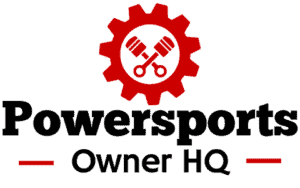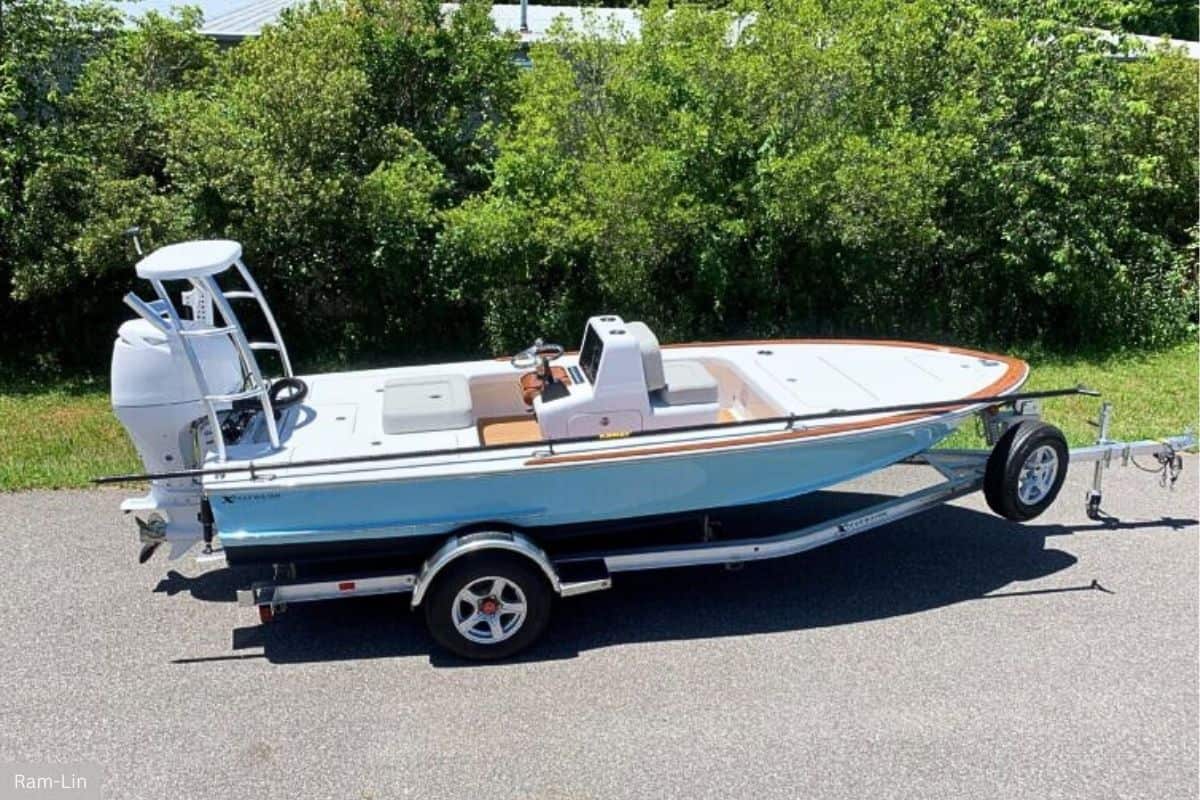ATVs, especially utility ATVs can tow all manner of things without much issue, including sleds, wagons, and even small trailers, due to the robust towing capacity of most ATVs, which usually ranges from 500 to 1,800 pounds, depending on the make and model.
If you’re eying that boat in your yard and thinking of moving it, however, you might be wondering if an ATV can tow a boat, as it would be super convenient to just jump on your ATV and quickly move it.
But can an ATV really tow something as bulky and as heavy as a boat?
Unfortunately, the answer to “Can an ATV tow a boat” is…well, maybe, as there are so many different factors you need to account for, such as:
- What is the maximum tow capacity of the ATV?
- What is the maximum hitch weight of the ATV?
- Does the ATV have the necessary hitch receiver for the boat trailer?
- How heavy is the combined weight of the boat and its trailer?
- How far and where do you need to tow the boat?
So let’s dig into all these questions and more.
By the end, you’ll know clearly whether an ATV can realistically and safely tow different-sized boats based on the real towing capacities and limitations of an ATV.
What Size Boat Can an ATV Tow?
When evaluating if an ATV can tow a boat, the most important factor to consider is the size and weight of the boat and trailer combination, as you never want to exceed the maximum tow capacity of your ATV.
Exceeding the tow rating of your four-wheeler even just for a short distance, can put excessive strain on critical components like the engine, transmission, drivetrain, suspension, tires, and brakes.
It can also compromise stability and control, and greatly increase stopping distances. All of which can ultimately lead to damage, mechanical failures, and even accidents.
So while that big bass boat may technically fit on your ATV’s hitch ball, that doesn’t mean you can safely tow it.
This leads us to our next point, which is that just because an ATV can physically pull a certain weight does not mean it can safely tow it.
This is because, you must all consider factors like maneuverability and stopping power, as an overloaded ATV can lose traction, jackknife uncontrollably, and take much longer to slow down.
Dangers of Towing Near or Over an ATV’s Max Tow Rating
When operating near max tow ratings, it’s vital to use extreme caution on any slopes or uneven terrain.
The shifted weight distribution greatly amplifies the risk of sideways rollovers or backward jackknifing on hills.
Even seasoned riders can quickly lose control of an ATV stretched to its limits towing too much weight.
Additionally, exceeding tow ratings can lead to premature wear, strain, and failures of drivetrain components that aren’t designed to handle the immense loads.
Repairs like replacing an entire gear case or engine are costly and far outweigh the time savings you might gain by towing your boat with your ATV.
Remember, that the tow rating thresholds set by manufacturers are not simply arbitrary numbers.
They are based on rigorous testing and safety margins performed by engineering teams who understand the true capabilities – and limitations – of their machines.
So to dismiss their guidance is reckless and asking for problems.
In short – don’t ever hitch up a trailer when the combined gross weight approaches your ATV’s established max tow rating, no matter the situation or distance.
It’s simply not worth the risk of damage, injury, or death.
Towing a Boat with a Small Recreational ATV
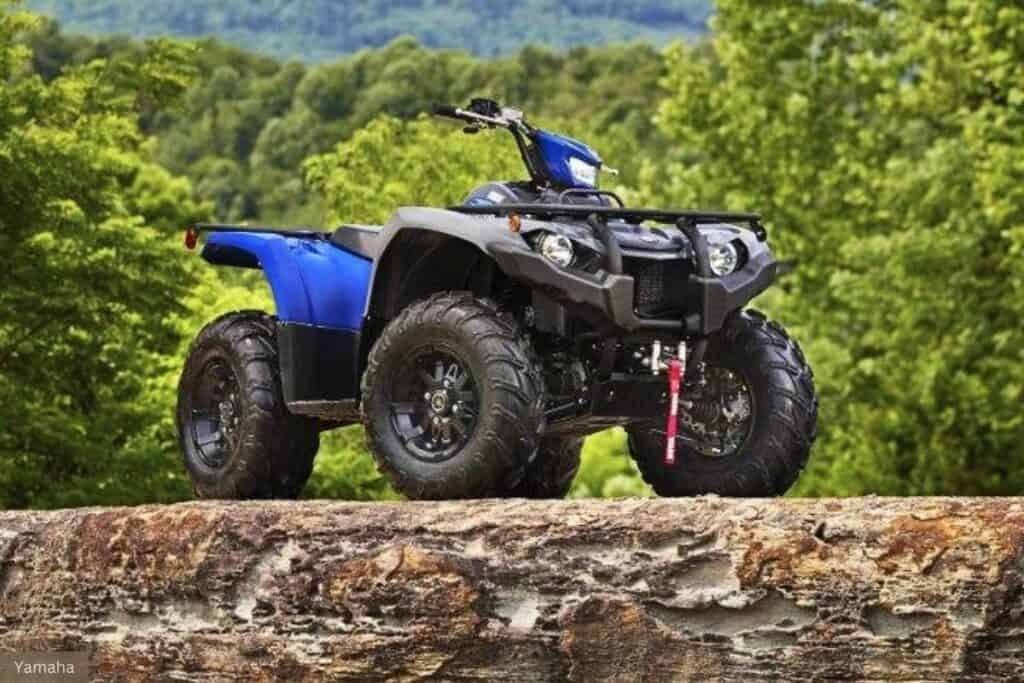
Towing capacity can vary greatly depending on the ATV make and model.
For example, many of the lighter recreational ATVs that are built more for trail riding or moderate jobs around a homestead offer pretty limited towing abilities.
Models in the 300cc to 500cc range with smaller engines and basic drivetrains often top out at around 500 pounds of towing capacity.
That rules out hauling anything larger than very small flat-bottom jon boats, canoes, or inflatable rafts.
And even with those tiny vessels, the strain on the ATV is still considerable.
Towing a Boat with a Mid-Size Utility ATV
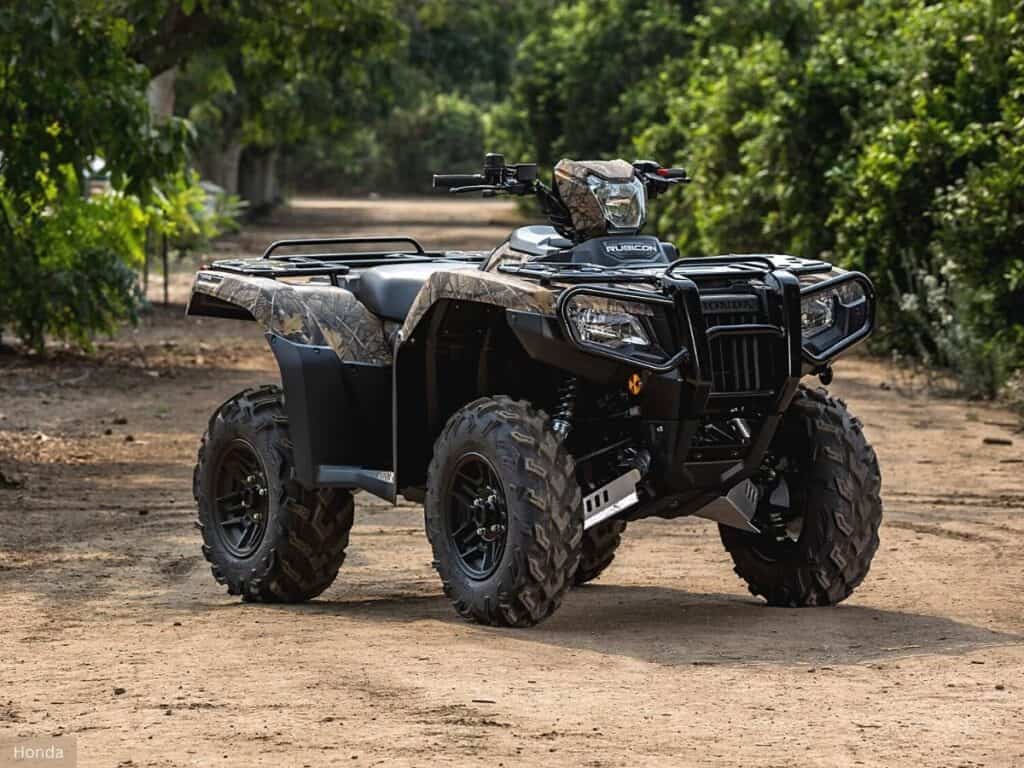
Stepping up to mid-sized utility ATVs in the 500cc to 800cc range designed for heavy duty tasks and fram work opens more possibilities, thanks to more robust frames, beefed-up drivetrains and transmissions, increased suspension travel, larger tires, and better braking power.
Many top mid-size utility ATVs boast over 1,000 pounds of towing capacity.
This means that these machines can usually tow small trailered aluminum fishing or bass boats for short distances, as long as their under the ATV’s max tow capacity.
Just be aware though that you’re more than likely pushing the limits of the quad, so it’s important to go slow and take it easy.
Towing a Boat with a Large Displacement Utility ATV
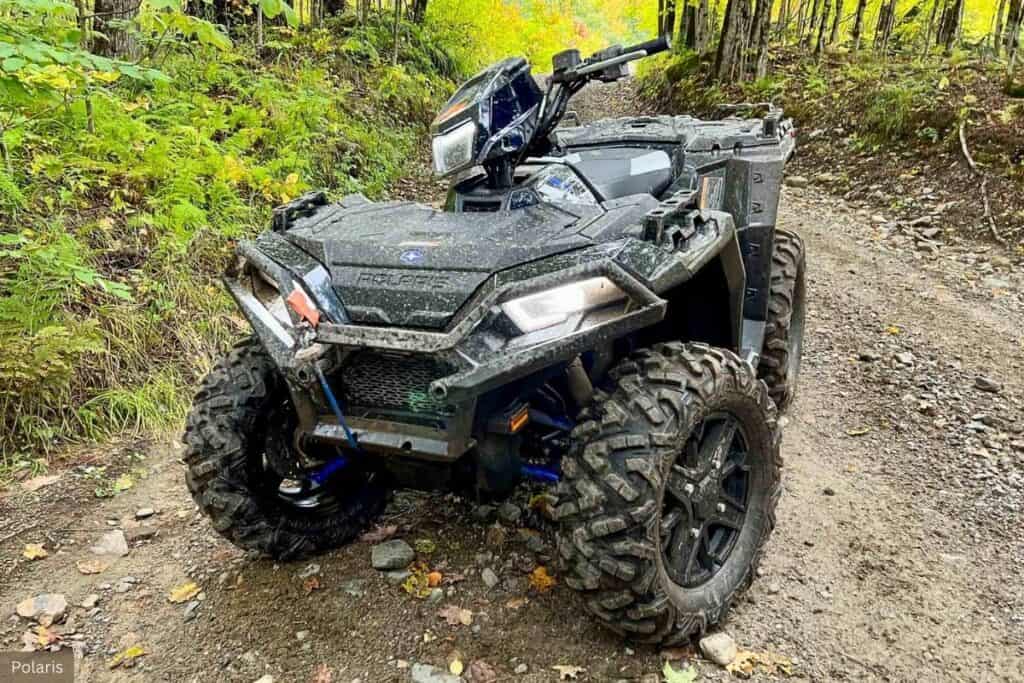
The true workhorse tow vehicles of the ATV world are large utility models with 800cc to 1,000cc engines.
These top-of-the-line models, which are typically produced by either Polaris or Can-Am offer specialty tow packages and robust hitches that allow their most powerful models to tow up to 1,500 or even 1,800 pounds!
Those massive tow ratings allow safe towing of many light single-axle trailers with boats at or over 1,000 pounds, just don’t forget to account for the weight of the trailer as well.
One of these premium big-bore ATVs could likely successfully tow an average-sized aluminum fishing boat between 14 to 18 feet under controlled conditions for short distances.
Factors that Determine ATV Towing Capacity and How Big of a Boat it Can Pull
An ATV’s towing capacity depends on multiple components and design factors, including everything from its engine displacement to its suspension setup.
Understanding these elements will help you better understand what allows certain models to tow more than others.
Key Aspects that Determine an ATV’s Tow Rating and Boat Pulling Capability
- Engine Size and Power – An ATV’s engine size and horsepower play a pivotal role in towing strength. More displacement, torque, and available power equates to pulling more poundage before maxing out. While a 300cc engine may suffice for light recreational duties, large utility engines in the 800cc and up range are best for towing boats.
- Drivetrain and Transmission – The drivetrain components like gears, shafts, and differentials must also withstand high loads without failing. How the transmission is geared is also important as lower gearing produces higher torque for towing and traction. Robust automatic or manual transmissions combined with stout drive components suited to towing are ideal.
- Braking Capacity – What good is an ATV that can pull weight but not stop properly? The braking system’s performance is crucial when towing heavy loads. Larger discs or drums, aggressive pads/shoes, and efficient cooling apparatus are essential for controlling momentum.
- Hitches and Tow Configurations – Proper hitch selection ensures the load is transferred to the ATV securely. Some models have custom hitches designed specifically to optimize weight distribution based on engineering tests. Others require aftermarket hitches properly rated for target loads. Appropriate ball size, anti-sway, and sufficient tongue weight are key.
- Suspension Setup – The suspension system is another crucial yet often overlooked component that impacts an ATV’s towing safety and ability. With a watercraft and trailer combination attached, huge forces are exerted both downward and dynamically with loads in motion. The suspension must be up to the task of controlling those loads. Independent suspension tuned for higher sprung and dampened travel capacity increases articulation which helps with towing stability. As does longer front and rear suspension travel. Wider wheel track widths along with improved high-traction tires are beneficial as well.
Equipment Needed to Tow a Boat with an ATV
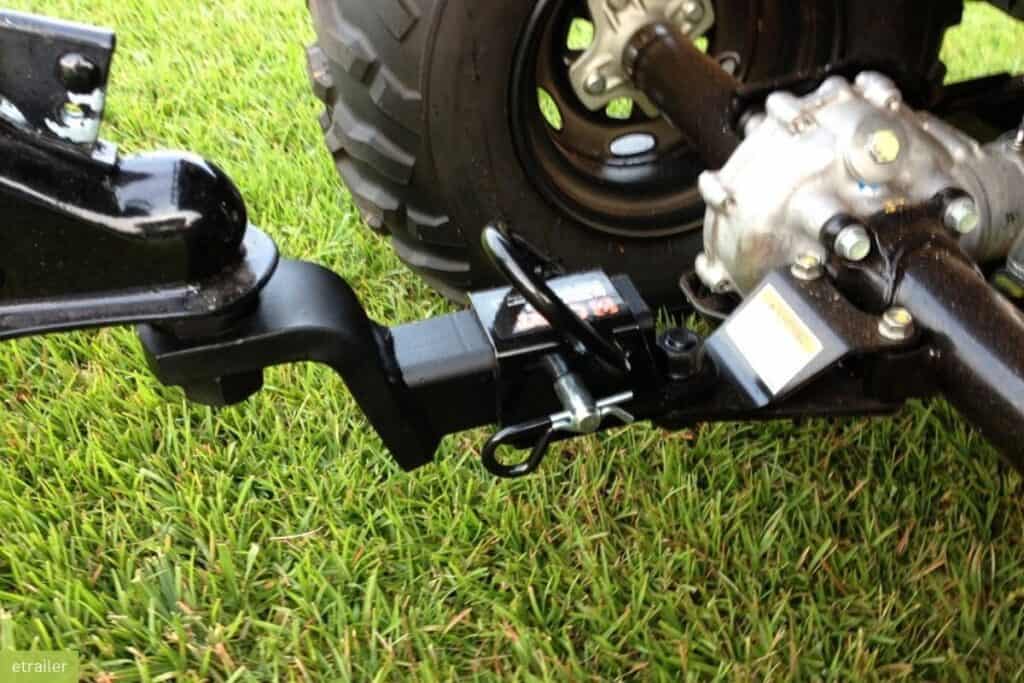
While some ATVs offer high towing capacities, that doesn’t mean you can simply back up to a boat, and hook it up, as you’ll need an assortment of towing equipment to safely pull a boat with an ATV.
- ATV Hitch Receiver – While many ATVs, especially utility variants come standard with a hitch receiver, if your ATV lacks a stock receiver you’ll need to purchase an OEM or aftermarket version and attach it properly to the back of the machine.
- ATV Hitch Ball – A properly sized hitch ball suited to the ATV’s hitch receiver and trailer’s tongue is critical, as there is a wide variety of both. Many boat trailers feature a tongue to accept a standard ball hitch. However, some use a lunette eye ring requiring a pintle hitch on the ATV instead. It’s also important to ensure your selected ATV hitch assembly is purpose-built and rated for the target gross boat and trailer weight.
- Safety Chains/Cables – Safety chains or cables that securely connect the ATV to the trailer are important even if you’re just towing the boat a short distance. As these cables prevent a “runaway trailer”, should the ball hitch unexpectedly detach while towing.
- ATV Mirrors – While not mandatory, one additional useful accessory when trailing boats behind an ATV are mirrors specifically designed for four-wheelers. As they help to keep an eye on the boat while it’s under tow. These are our favorite after-market ATV mirrors for towing.
What’s Not on the List and Why
Looking down through the list of towing equipment you might have noticed some common towing accessories missing from the list, such as a wiring harness or adapter to operate trailer lights and brake lights. As well as trailer brake controls with breakaway capability, for emergency stopping in case the trailer detaches from the hitch.
There’s a good reason for this though and that’s because an ATV should never be used to tow a boat on public roads or streets.
ATVs are intended for off-road use only and cannot legally or safely drive on highways amongst normal road traffic.
Plus, they lack crucial safety features like signals, mirrors, and adequate lighting.
Any need to move a boat at significant distances across roads should only be done with suitable tow vehicles rated for that function like full-size trucks equipped with proper electrical integration, brake controls, weight-distributing hitches, sway bars, and other necessary equipment.
Things to Keep in Mind When Towing a Boat with an ATV
While we’ve covered maximum four-wheeler tow ratings, there are additional factors to remember before hitching up a boat to ensure safe, reliable ATV towing, which we’ve outlined below.
- Vehicle Stability Concerns – Towing heavy trailer loads fundamentally alters weight distribution and center of gravity, which will ultimately reduce stability. Even low-speed maneuvering across boat launches risks traction loss or sideways rollover accidents. So be sure to apply trailer brakes gradually and avoid sharp turns whenever possible.
- Stopping Distance Greatly Increased – The momentum of a towed boat trailer assembly dramatically lengthens stopping distance which could already be compromised if pushing the limits of the ATV. So begin slowing earlier than normal, avoid panic braking, and account for slipping during descents.
- Reversing Difficulties – Reversing an ATV with a towed trailer takes immense care and skill to avoid dangerous jackknifing scenarios.
- The strain on Critical Components – When nearing upper tow thresholds, it’s important to keep in mind the strain you’re placing on the ATV’s drivetrain, wheel bearings, suspension, and brakes. So while towing any trailered load you should always go slow to reduce the strain on the ATV.
Tips for Safely Towing a Boat with an ATV
If you determine your ATV is, in fact, capable of safely towing your boat given all the above-mentioned criteria, you should still exercise abundant caution.
And the best way to do that is to follow the below tips when towing your boat with an ATV.
- Double-check hitch assembly, safety chains, and ring/ball size suitability, and inspect for wear before each tow.
- Allow for extended braking distance with additional time to slow and come to a gradual stop.
- Avoid panic turns, swerves, or brake use that could create instability with the heavy towed load.
- Load gear strategically in the boat and secure all items to keep weight balanced and stable.
- Steer clear of any steep grades exceeding 10% during ascents or descents while towing.
- Maintain reasonably low towing speeds appropriate for the terrain with margins for traction loss.
- Use extreme care on slippery boat launch ramps and when coupling/uncoupling the trailer tongue from the ATV hitch.
- Back up the trailer only when necessary, ideally with a spotter guiding to prevent jackknifing.
- Engine temperatures may increase quickly from the strain of towing so monitor gauges closely for any overheating.
Additional ATV Resources:
- Does ATV Oil Go Bad? (When to Replace It & Toss It Out)
- Do ATVs Have VIN Numbers? Decoding Vehicle Identification Numbers
- Are ATV Keys Universal? Everything You Need to Know
Recent Posts
In recent years, off-road enthusiasts have been taking their adventures to the next level by installing UTV underglow lights on their side-by-sides. Which adds a unique visual appeal and improves...
Side by sides, also known as UTVs, are used by a wide range of outdoor enthusiasts from off-roaders to farmers to ranchers, and hunters. As these versatile machines offer a unique blend of...
